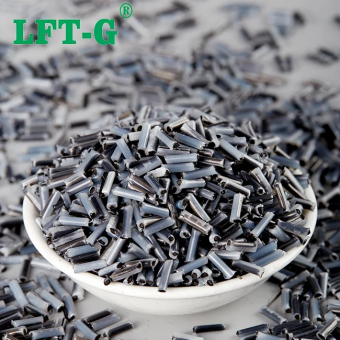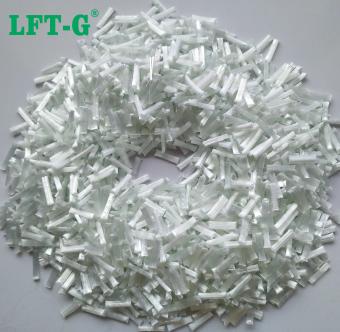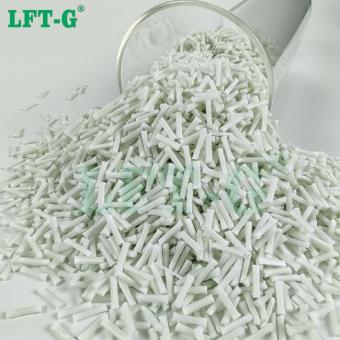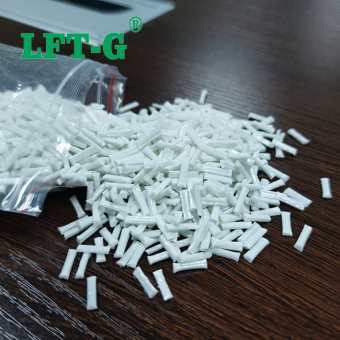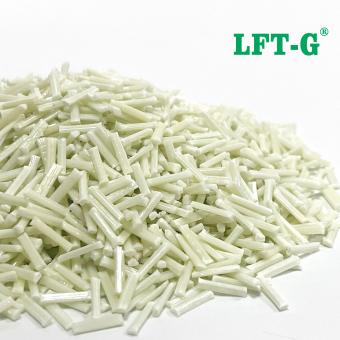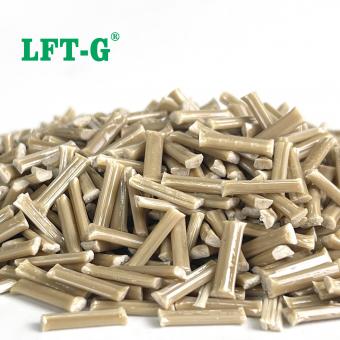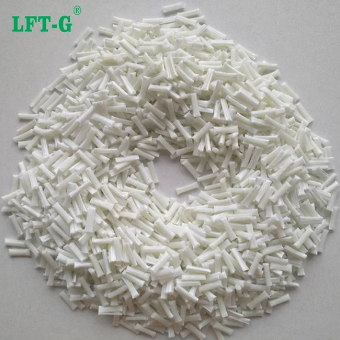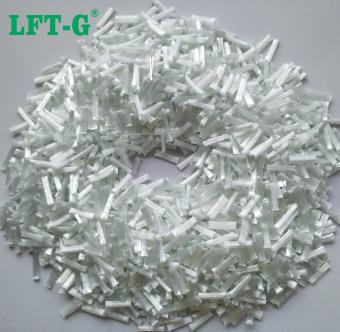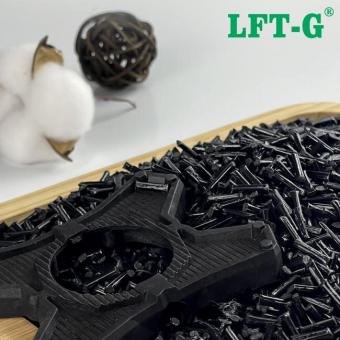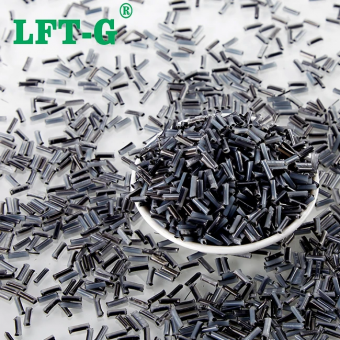-
LFT PPS long glass fiber reinforcement thermoplastic composite granulesPPS long glass fiber reinforced thermoplastic granules for introduction and properties
- glass fiber pps thermoplastic material
- pps fiber injection molding Polyphenylene sulfide
- pps lgf glass fiber car parts frame
- natural color pps lgf composite
- PPS polymer glass fiber pellets
- thermoplastic virgin granules PPS
Tags :
-
Xiamen LFT PP Polypropylene engineeing plastic long glass fiber composite granules 12mmWhat is long glass fiber? Long glass fiber reinforced plastic is on the basis of the original pure plastic, adding long glass fiber and other additives, so as to improve the scope of use of materials. Why filling Long Glass Fiber? 1. After long glass fiber reinforcement, long glass fiber is a high temperature resistant material, therefore, the heat resistance temperature of reinforced plastics is much higher than before without long glass fiber, especially nylon plastics; 2. After long glass fiber reinforcement, due to the addition of long glass fiber, limited the mutual movement between polymer chains of plastics, therefore, the shrinkage rate of reinforced plastics decreases a lot, rigidity is greatly improved; 3. After long glass fiber reinforcement, the reinforced plastic will not stress crack, at the same time, the anti-impact performance of plastic is improved a lot; 4. After long glass fiber reinforcement, long glass fiber is a high strength material, which also greatly improves the strength of plastic, such as: tensile strength, compression strength, bending strength, improve a lot; 5. Long glass fiber reinforced after, due to the addition of long glass fiber and other additives, the combustion performance of reinforced plastics decreased a lot, most of the material can not ignite, is a kind of flame retardant material. Why choose Long Glass Fiber instead of Short Glass Fiber? Compared with short fiber reinforced thermoplastic composites, LFT has the following advantages: • Long fiber length, significantly improve the mechanical properties of products. • High specific stiffness and strength, good impact resistance, especially suitable for automotive applications. • Improved creep resistance, good dimensional stability, high parts forming accuracy. • Excellent fatigue resistance. • Better stability in hot and humid environments. • The fiber can move relatively in the molding mold during the molding process, and the fiber damage is small. Appearance of PP-LGF Application of PP-LGF Automotive parts Front end module, door module, shift mechanism, electronic accelerator pedal, dashboard skeleton, cooling fan and frame, battery carrier, bumper bracket, underbody protection plate, sunroof frame, etc., used to replace reinforced PA or metal materials. Household appliance Washing machine drum, washing machine triangle bracket, one brush machine drum, air conditioning fan, etc., used to replace short glass fiber reinforced PA, APS metal materials. Communications, electronics, electrical appliances High-precision connectors, igniter components, coil shaft, relay base, microwave oven transformer coil frame/frame, electrical connector, solenoid valve package, scanner components, etc. Others Power tool housing, water pump or water meter housing, impeller, bicycle skeleton, skis, ground locomotive pedals, military/civil safety helmets, safety shoes, etc. are used to replace short glass fiber reinforced PA, PPO, etc. Datasheet for reference About us Xiamen LFT composite plastic Co., Ltd. is a brand-name company that focuses on LFT&LFRT. Long Glass Fiber Series (LGF) & Long Carbon Fiber Series (LCF). The company's thermoplastic LFT can be used for LFT-G injection molding and extrusion, and can also be used for LFT-D molding. It can be produced according to customer requirements: 5~25mm length. The company's long-fiber continuous infiltration reinforced thermoplastics have passed ISO9001 &16949 system certification, and the products have obtained lots of national trademarks and patents. We will offer you: 1. LFT&LFRT material technical parameters and leading edge design; 2. Mold front design and recommendations; 3. Provide technical support such as injection molding and extrusion molding.
- Polypropylene filling lgf GFRP 30
- thermopalstic Polymer virgin grade
- LFT-G car parts home appliance parts
- PP resin GF made in China modified plastic
- long fiber compounds pp instead metal and steel
- injection molding pp composite
Tags :
-
Xiamen LFT ABS (Acrylonitrile Butadiene Styrene) Long Glass Fiber Reinforced Thermoplastic CompoundsABS is another preferred type of engineering plastic that is valued for its chemical and thermal stability, strength, toughness, and glossy finish. Its host of desirable properties make it a versatile material. It is used in everything from consumer products like toys and bicycle helmets to automotive applications such as interior trim pieces, housings for electronics, and more. After adding glass fiber to ABS, the rigidity, heat resistance and dimensional stability of the composite are significantly improved. In addition, the cost performance of ABS plus glass fiber is extremely good, which can meet the needs of manufacturers while reducing costs. About ABS-LGF compounds The main application scope of modified ABS: 1. Auto parts: instrument panels, fenders, car interiors, car lights, reversing mirrors, car audio; 2. Electronic and electrical components: IT equipment, OA equipment shells, converters, etc., power sockets, etc.; 3. Electronic appliances: switches, power switches, controllers, monitors, monitor housings, electrical housings, electrical brackets; 4. Home appliances: electrical components, electrical control boxes What Are the Advantages of ABS Injection Molding? The advantages of ABS injection molding are: 1. High Productivity - Efficiency Injection molding is a highly efficient and productive manufacturing technology and is the preferred method of manufacturing ABS parts. The process creates limited waste and can produce large volumes of parts with limited human interaction. 2. Design of Complex Parts Injection molding can produce multi-featured, complex components that can include metal inserts or overmolded soft-grip handholds. 3. Increased Strength ABS is a strong, lightweight thermoplastic that is widely used in a number of industries due to these properties. As such, injection molding in ABS is ideal for applications that require increased durability and overall mechanical strength. 4. Flexibility of Color and Material ABS is easily colored with a wide range of colors. It must be noted however that ABS has poor weathering resistance and can be degraded by UV light and prolonged outdoor exposure. Fortunately, ABS can be painted and even electroplated with metal to improve its environmental resistance. 5. Decreased Waste Injection molding is inherently low-wastage production technology due to the large production volumes that injection molding was designed for. When millions of parts are made per year, any amount of wastage adds up to a significant cost over time. The only wastage is the material in the sprue, runners, and the flashing between mold halves. 6. Low Cost of Labor Due to the highly automated nature of injection molding, very limited human intervention is required. Reduced human intervention results in reduced labor costs. This reduced labor cost ultimately results in a low cost per part. Materials Details Number ABS-NA-LGF Color Natural color or Customized Length 6-25 mm Package 25kg/bag MOQ 25kg Lead time 2-15 days Port of Loading Xiamen Port Trade terms EXW/FOB/CFR/CIF/DDU/DDP About Xiamen LFT Xiamen LFT Composite Plastic Co.,LTD was established in 2009, is a brand-name global suppliers of long fiber reinforced thermoplastic materials integrating product research & developmen (R&D), production and sale marketing. Our LFT products have passed the ISO9001&16949 system certification and have obtained lots of national trademarks and patents, covering the fields of automotive, military parts and firearms, aerospace, new energy, medical equipment, power wind energy, sports equipment, etc. LFT long fiber reinforced thermoplastic engineering materials,compared to ordinary short fiber reinforced thermoplastic materials (fiber length is less than 1-2 mm), the LFT process produces thermoplastic engineering material's fibers in lengths of 5-25 mm. The long fibers are impregnated with the resin through a special mold system to obtain long strips that are fully impregnated with the resin ,and then cut to the length as required. The most used base resin is PP, by PA6, PA66, PPA,PA12,MXD6,PBT,TPU,PPS, ABS,PEEK, etc. Conventional fibers include glass fiber, carbon fiber. Depending on the end use, the finished products can be used for injection molding,extrusion, molding, etc., or directly used for plastic instead of steel and thermoset products.
- High performance thermoplastic engineering plastics
- excellent heat resistance with filler
- injection molding products light weight
- automotive parts house hold appliances
- modified plastic manufacturer can be customized
- can be recylced GFRP GF30
Tags :
-
LFT-G® Polypropylene Homopolymer Long Carbon Fiber Filled Compounds Injection Molding PelletsGeneral characteristics of PP row materials 1. Colorless, tasteless, non-toxic 2. Due to the crystallization of PP, the natural milky translucent, transparency is better than PE 3. The specific gravity is as low as 0.9, which is smaller than water and is almost one of the lightest plastics 4. Good toughness, especially repeated bending resistance 5. Better heat resistance than PE 6. Good hydrolysis resistance, high temperature steam disinfection 7. Chemical resistance, especially acid resistance is very good, can be due to the storage of concentrated sulfuric acid containers 8. Outdoor use is easy to be aging by light and ultraviolet rays Long Carbon Fiber Reinforced PP Compounds Carbon fiber reinforced composite (CFRP) is composed of carbon fiber as a reinforcement material and resin as a matrix material, and early carbon fiber composite materials are mainly used in the military field. With the improvement of material properties, molding process and price cost, carbon fiber composite materials are more and more used in general industry and sports and leisure fields. Polypropylene is a low cost, excellent performance, a wide range of uses of polymer materials, through carbon fiber reinforcement, can improve the strength of polypropylene materials, thermal deformation temperature and dimensional stability, expand the application of polypropylene materials, widely used in electronic appliances, automobiles, construction and other fields. Especially in the automotive field, with the development of new energy vehicles and the trend of lightweight vehicles, carbon fiber reinforced materials are more and more widely used in the automotive field. Carbon fiber reinforced polypropylene material features: High mechanical properties In line with the design trend of new energy vehicles The lower density meets the needs of lightweight vehicles The modified PP reinforced by carbon fiber has a series of advantages, such as light weight, high modulus, high specific strength, low coefficient of thermal expansion, high temperature resistance, heat shock resistance, corrosion resistance, good vibration absorption, etc., and can be applied to auto parts such as automobile sub-instrument assembly. (PP-LCF) Why are these pellets so long? LFT long fiber reinforced thermoplastic engineering materials,compared to ordinary short fiber reinforced thermoplastic materials (fiber length is less than 1-2 mm), the LFT process produces thermoplastic engineering material's fibers in lengths of 5-25 mm. Due to different production processes, the length and distribution of carbon fibers retained in the resin are different. As a result, the fibers inside the long-fiber composite are longer and more regular than those inside the short-fiber composite. Long-fiber reinforced composites show excellent mechanical properties compared to short fibers and are more suitable for applications requiring high strength. The impact performance of long fiber composites is 1-3 times higher than that of short fibers, tensile strength is more than 50% higher, and mechanical properties are 50-80% higher. Compared with traditional short fiber materials, the main features of LFT-G thermoplastic long glass fiber and long carbon fiber are mechanical properties, high impact and tensile modulus, which are more suitable for some large products or structural load-bearing parts. It can do Injection molding, extrusion of sheets, profile pipes, etc. Q & A What is the Maximum Operating Temperature of Thermoplastic? The maximum operating temperature of a thermoplastic usually refers to the temperature at which the mechanical properties of the plastic begin to degrade. Every thermoplastic has its own maximum continuous operating temperature. This property can be further impacted by additives meant to improve thermal stability. Xiamen LFT can provide you with data sheets tested by our own laboratory. Does long glass fiber and long carbon fiber injection have special requirements for injection molding machines and molds? There are certainly requirements. especially from the product design structure, as well as the injection molding machine screw nozzle and mold structure injection molding process must consider the requirements of long fiber. Are long fiber reinforced composites suitable for other processes besides injection molding? In addition to injection molding, LFT long glass fiber and long carbon fiber can also be used for extrusion of sheets, profiles, pipes and molding, among which injection molding is the most common. About Xiamen LFT Xiamen LFT Composite Plastic Co.,LTD was established in 2009, is a brand-name global suppliers of long fiber reinforced thermoplastic materials integrating product research & developmen (R&D), production and sale marketing. Our LFT products have passed the ISO9001&16949 system certification and have obtained lots of national trademarks and patents, covering the fields of automotive, military parts and firea...
- LFT materials PP thermoplastic
- CFRP automotive parts car
- High mechanical strength toughness stifiness
- Fiber filled composites granules 12mm
- Virgin can be recycled
- home appliance parts use outdoor UV resistance
Tags :
-
LFT-G® Polyamide 66 Long Carbon Fiber Filled Compounds Injection molding pelletsWhat is LFT Materials? LFT long fiber reinforced thermoplastic engineering materials,compared to ordinary short fiber reinforced thermoplastic materials (fiber length is less than 1-2 mm), the LFT process produces thermoplastic engineering material's fibers in lengths of 5-25 mm. The long fibers are impregnated with the resin through a special mold system to obtain long strips that are fully impregnated with the resin ,and then cut to the length as required. The most used base resin is PP, by PA6, PA66, PPA,PA12,MXD6,PBT, PET,TPU,PPS, LCP,PEEK, etc. Conventional fibers include glass fiber, carbon fiber,special fibers include basalt fiber and quartz fiber, etc. Depending on the end use, the finished products can be used for injection molding,extrusion, molding, etc., or directly used for plastic instead of steel and thermoset products. Long carbon fiber reinforced composites can solve your problems when other methods of reinforced plastics do not provide the performance you need or if you want to replace metal with plastic. Long carbon fiber reinforced composites can cost-effectively reduce the cost of goods and effectively improve the mechanical properties of engineering polymer. Long fibers can be uniformly distributed inside the product to form a network skeleton, thus improving the mechanical properties of the material product. What is Polyamide 66 Long Carbon Fiber Reinforcement? Nylon 6,6, also written as nylon 6-6, nylon 66, or nylon 6/6, is a more crystalline version of nylon 6. It is also referred to as polyamide 66 or PA 66. It has improved mechanical properties due to its more ordered molecular structure. Nylon 66 for machining has improved temperature resistance and lower rates of water absorption when compared to standard nylon 6. The advantages of nylon 6,6 are that the yield strength is higher than nylon 6 and nylon 610. It has high strength, toughness, rigidity, and low coefficient of friction in a wide temperature range. In addition, it is oil resistant and resistant to chemical reagents and solvents. However, PA66 has strong hygroscopicity and poor dimensional stability, which limits its application. In order to obtain nylon 66 engineering material with higher strength, it should be modified by carbon fiber reinforcement. The mechanical properties of long carbon fiber reinforced nylon 66 (LCFR-PA66) are obviously better than those of short carbon fiber reinforced nylon 66 (SCFR-PA66), and the molding processing performance is also better. It can be molded by various molding methods such as injection molding and compression molding, and complex components can also be formed. Therefore, long carbon fiber reinforced nylon 66 can be widely used in building materials, aerospace, electronic devices, furniture and other fields, especially in the automotive industry application market. The production process of long carbon fiber reinforced nylon 66 is different from that of short carbon fiber reinforced nylon 66. The short carbon fiber reinforced nylon 66 particle is chopped under the friction and shearing of screw and barrel, and the short carbon fiber reinforced nylon 66 particle is obtained with the length of carbon fiber monofilament about 0.5mm. The length of some carbon fiber monofilament in the final product is lower than the critical length of reinforcement, and the carbon fiber is easy to be extracted from the nylon 66 matrix when the product is stressed. The strength of carbon fiber is not fully utilized, and the mechanical properties of the product are not high. Long carbon fiber reinforced nylon 66 has better reinforcement effect and dimensional stability, and the rigidity, tensile, bending, impact resistance and fatigue resistance of the manufactured products are better, and the service life is longer. Q & A Q: Does long glass fiber and long carbon fiber injection have special requirements for injection molding machines and molds? A: There are certainly requirements. especially from the product design structure, as well as the injection molding machine screw nozzle and mold structure injection molding process must consider the requirements of long fiber. Q. The product is easy to brittle, so changing to use long fiber reinforced thermoplastic materials can solve this problem? A: The overall mechanical properties must be improved. The characteristics of long glass fiber and long carbon fiber are the advantages in mechanical properties. It has 1-3 times higher (toughness) than short fiber , and the tensile strength(strength and rigidity) is increased by 0.5-1 times. Q. How to choose the reinforcement method and length of the material when using long fiber reinforced thermoplastic material? A: The selection of materials depend on the requirements of the products. It is necessary to assess how much the content is enhanced and how muc...
- Reinforced thermoplastic resin composites
- Nylon PA 6.6 high strength plastic
- China manufacturer engineering plastic
- CF filament enhanced materials
- long cut fiber instead metal and steel
- high mechanical properties
Tags :
-
LFT-G High Quality Nylon Polyamide 6 Long Carbon Fiber Reinforced PlasticsPolyamide 6 Profile PA66+LGF60 Polytron A60N01 is Natural, 60% Long Glass Fiber Reinforced, Heat Stabilized POLYAMIDE 66, The Glass Fibers are Chemically Coupled to the Polymer Matrix, The material is supplied in pellets that are typically 12mm in length. Fiber length is the length of the pellets. Typical applications include Injection Molding Applications. Production Process of LGF 1. Through the physical and chemical treatment of the original carbon fiber, it removes impurities, improves surface activity, and provides the mechanical properties and durability of pre-soaked materials. 2. Add resin, additives, etc., form a unique formula. Improve flowability, hardness, temperature stability. 3. The pre-treated carbon fiber is placed on the machine, and the resin is evenly covered on its surface. 4. Use the machine to solidify the material, and the fiber and resin are both sufficiently bonded. 5. According to the requirements of the product, cutting particles. What are the advantages and applications of Polyamide 6? Nylon 6 fibers are tough, possessing high tensile strength, elasticity, and luster. The fibers can absorb up to 2.4% of water, although this lowers tensile strength. The glass transition temperature of nylon 6 is 47 °C. Nylon 6 is generally white as a synthetic fiber but can be dyed in a solution bath before production for different color results. The tenacity of nylon 6 is 6–8.5 gf/D with a density of 1.14 g/cm3. Its melting point is 215 °C and can protect heat up to 150 °C on average. The applications of nylon 6 include construction material in many industries, including the automotive industry, electronic and electrotechnical industry, aircraft industry, clothing industry, and medicine. The advantages of nylon 6 are that its fibers are wrinkleproof and highly resistant to abrasion and chemicals such as acids and alkalis. Long fiber reinforced thermoplastics are an excellent option to consider for metal replacement at a fraction of the weight. About Xiamen LFT laboratory Warehouse Xiamen LFT has capabilities to provide assistance to you throughout an entire product launch - through product discussion, performance analysis, composite selection, composite pellet production, after-sales tracking. In addition, we provide guidance on injection molding techniques
- PA6 GFRP engineering plastic
- Manufacturer directly sell good price plastic
- Thermoplastic resin modified polymers
- customization service
- car parts lightweight instead metal
- composites made in China high toughness
Tags :
-
LFT-G Polyetheretherketone filling Long Carbon Fiber Polymers extra high strengthPEEK-Long carbon fiber Polyetheretherketone (PEEK), the complete English name for polyetheretherketone, is a specialty engineering plastic with excellent performance, and has more advantages than other specialty engineering plastics, such as wear resistance, high temperature resistance, high strength and high modulus, flame retardant and radiation resistant, and so on. In addition polyetheretherketone (PEEK) has good thermal stability and melt flow above the melting point, so polyetheretherketone (PEEK) also has the typical processing properties of thermoplastics. PEEK resin is nontoxic, lightweight, corrosion-resistant, and one of the closest materials to the human skeleton, which is well compatible with the musculature, so it is often used instead of metal to make human bones. Carbon fiber-reinforced PEEK composites make up for the weaknesses of toughness and deviations in impact strength. Carbon fiber-reinforced PEEK composites can exhibit high mechanical strength and hydrolytic stability under conditions such as hot water, steam, solvents, and chemical reagents, and can be used to prepare various medical devices that require high-temperature steam sterilization. Advantages of PEEK-LCF PEEK has high rigidity, good dimensional stability, low coefficient of linear expansion, and can withstand great stress without significant elongation over time, and its low density and good processing properties make it suitable for parts with high requirements for fineness. Among these elements, carbon fiber materials overlap highly with the characteristics of PEEK. Carbon fiber is not only one of the typical lightweight materials, it is also outstanding in terms of mechanical properties. As a result, carbon fiber reinforced PEEK composites can reduce weight by at least 70% compared to traditional metal materials. PEEK material itself is very wear-resistant, and good interface bonding with carbon fibers to further enhance its wear resistance, through the carbon fiber reinforced PEEK composite parts and cobalt alloy materials for wear comparison experiments, the results show that: at 23 ℃, using the M-200 wear machine at 400 rpm after 100 minutes of wear, found that the carbon fiber reinforced PEEK composite surface smooth The wear marks were small, and the carbon fiber bonded well with PEEK without fiber extraction. In contrast, the cobalt alloy surface wear marks are very obvious, even a large number of wear particles appear, the metal internal impurities image visible. PEEK exhibits high mechanical strength and hydrolytic stability in hot water, steam, solvents and chemical reagents, etc. Datasheet for reference PEEK-LCF application Q&A 1. What are the types of thermoplastic carbon fiber composites? Carbon fiber thermoplastic composites are composites with carbon fiber as the reinforcing material and thermoplastic resin as the matrix. From the reinforcement method of carbon fiber, it can be divided into long-cut carbon fiber (LCF) reinforced thermoplastic composites, short-cut carbon fiber (SCF) reinforced thermoplastic composites and continuous carbon fiber (CCF) reinforced thermoplastic composites. Long-cut carbon fiber and short-cut carbon fiber mainly refer to the application length of carbon fiber materials, there is no strict fixed distinction between the two, generally between a few millimeters to a few centimeters, the more common specifications are 6mm, 12mm, 20mm, 30mm, 50mm. Carbon fiber thermoplastic composites can also be classified according to the thermoplastic resin. There are many common thermoplastic resins, such as PE, PP, PVC, etc. However, thermoplastic resin composites with carbon fiber reinforcement are mostly used in aerospace, precision equipment and other demanding working environments, therefore, carbon fiber thermoplastic composites are more often made of polyether ether ketone (PEEK), PPS, polyimide ( PI), polyetherimide (PAI) and other mid- to high-end thermoplastic resins as the matrix to achieve the optimization of material performance. 2. How does thermoplastic carbon fiber composite material achieve low cost and environmental protection? Thermoplastic carbon fiber composites are used to make parts for high-end machinery. They have excellent machinability, vacuum forming, stamping mold plasticity, and bending processability. For example, Teijin has been able to add a recycling process to the process according to specific needs, and to shred and mold the corners of thermoplastic carbon fiber composite materials after stamping to make recycled materials for making small products or for molding nuts and studs on carbon fiber prototypes. This method can greatly reduce the loss of raw materials, improve the efficiency of the use of thermoplastic carbon fiber composite materials, reduce the overall cost, and thus achieve the purpose of environmental protection. In addition, thermoplastic carbon fiber composites can reduce the molding cycle time compared with thermoset carbon fiber composi...
- PEEK with long carbon fiber compounds
- Modified Plastic pellets peek engineering plastic
- factory in Xiamen thermoplastics
- peek cf30 injection molded 3D print
- PEEK pellets lcf 30 polymer resin carbon fibre
- self owing peek pellets reinforcement
Tags :
-
LFT-G Polypropylene long carbon fiber filled PP high mechanical properties polymerWhat is Long carbon fiber (LCF) Carbon fiber was first used in aviation, military and other fields, and later was cited in the production of racing car parts. In recent years, it began to come into the consumer market, and is also one of the materials that international manufacturers are keen on. Carbon fiber composite materials are characterized by very light, rigid, and can withstand the same pressure as steel, the cost is higher. However, the material is more durable and has a high recycling value, so it can save costs to a certain extent. Carbon fiber composites include carbon fiber powders, short fibers, long fibers, and long fiber reinforced composites. Long carbon fiber composites have better mechanical properties than short carbon fiber composites, but there are certain requirements for the injection molding machine and mold of the product. Carbon fiber has excellent mechanical properties and chemical stability, lower density than aluminum, higher strength than steel, is the highest specific strength and highest specific modulus among the high-performance fibers that have been produced in large quantities, and has the characteristics of low density, corrosion resistance, high temperature resistance, friction resistance, fatigue resistance, high electrical and thermal conductivity, low coefficient of thermal and wet expansion, etc. It is an important strategic material for the development of national defense and national economy. The characteristics of corrosion resistance, high temperature resistance and low coefficient of expansion make it an alternative material to metal materials in harsh environments; the electrical and thermal conductivity properties expand its application in the field of communications and electronics; as the highest specific strength (strength to density) and highest specific stiffness (modulus to density) among the high-performance fibers currently in mass production, carbon fiber is an important material for aerospace, wind power blades, new energy vehicles, transportation, sports and leisure, etc, Carbon fiber is an ideal material for aerospace, wind power blades, new energy vehicles, transportation, sports and leisure, and other fields with light weight needs. Xiamen LGT-G LCF compounds have the following appearance: Flat grain, very light weight, shows flawless finish, no floating fibers, bubbles, etc. The color is natural black and the length is around 6 to 25 mm. The application of PP filling long carbon fiber compounds Datasheet for reference Homo-PP & Copo-PP PP is divided into homopolymer PP and copolymer PP according to the different types of monomers involved in polymerization. Homopolymer PP is made by polymerization of propylene monomer only, and there is only one kind of link in the polymer molecular chain, with high crystallinity and good mechanical properties and heat resistance. Copolymerized PP is mainly made of propylene monomer and ethylene monomer, and there are ethylene links in addition to propylene links in the polymer molecular chain, which has high impact resistance. HPP composites and CPP composites, both of them are available for us. Details Number Color Length Package Sample MOQ Port of Loading Delivery time HPP-NA-LCF Natural color, or customized 6-25mm 20kg/bag Available 20kg Xiamen Port 7-15 days after shipment Certifications Test Xiamen LFT composite plastic CO., Ltd. Xiamen LFT composite plastic Co., Ltd. is a brand-name company that focuses on LFT&LFRT. Long Glass Fiber Series (LGF) & Long Carbon Fiber Series (LCF). The company's thermoplastic LFT can be used for LFT-G injection molding and extrusion, and can also be used for LFT-D molding. It can be produced according to customer requirements: 5~25mm length. The company's long-fiber continuous infiltration reinforced thermoplastics have passed ISO9001&16949 system certification, and the products have obtained lots of national trademarks and patents. Please contact Ms. Wallis for more information. Email: sale02@lfrtplastic.com Whatsapp: (+86) 13950095727
- Long carbon fiber Reinforced Polypropylene for electrial accessories
- PP pellets lcf 30 polymer compounds resin
- best long carbon fiber pp lcf30 granules
- carbone fiber reinforced pp pellets
- pp lcf injection mold extrusion mold thermoplastic
- pp modified granules manufacturer
Tags :
-
LFT Polyphenyl Sulfide PPS Long Carbon Fiber Reinforced flame retardantPolyphenylene sulfide is a new functional engineering plastic.
- Polyphenyl sulfide long carbon fibre
- PPS plastic rein forced compounds
- Composite material pps industrial use
- Filling lcf 30 pps composite plastic new materials
- High flame retardant car parts
- Factory use raw material modified plastic high performance
Tags :
-
Xiamen LFT Polyamide 12 filling long glass fiber compounds high rigidity and toughnessPA12 PA12 polyamide or nylon 12 Chemical and physical properties of PA12 PA12 is a linear, semi-crystalline - crystalline thermoplastic material from butadiene. Its properties are similar to PA11, but its crystal structure is different. PA12 is a good electrical insulator and will not be affected by moisture as other polyamides. PA12 has good impact resistance mechanical and chemical stability. There are many improved varieties of PA12 in terms of plasticizing and reinforcing properties. Compared with PA6 and PA66, these materials have lower melting point and density, and have very high moisture recovery. PA12 has no resistance to strong oxidizing acids. The viscosity of PA12 depends mainly on humidity, temperature and storage time. PA12 It's very liquid. The shrinkage rate of PA12 is between 0.5% and 2%, depending on the variety of PA12 material, wall thickness and other process conditions. PA12 compounds plastic Nylon glass fiber material is a kind of composite material, adding glass fiber on the basis of the original nylon material, so that the material has the following characteristics: High temperature resistance, good dimensional stability, good toughness, good insulation, corrosion resistance, high mechanical strength. LGF & SGF comparison Compared with the short fiber, it has more excellent performance in mechanical properties. It is more suitable for large products and structural parts. It has 1-3 times higher (toughness) than short fiber, and the tensile strength (strength and rigidity) is increased by 0.5-1 times. Datasheet for reference Application ■ Power tools: cutting machine, electric saw, electric drill, Angle grinder, polishing machine, electric hammer, electric pick, hot air gun and other models; ■ Automotive industry: cooling chamber, intake manifold, frame bracket, ventilation grille, door handle, throttle body and other models; ■ Machinery industry: water pump, water valve, bearing, shaft sleeve, gear, bracket and other models; ■ Sports equipment: ski equipment, baby carriage, fitness equipment parts and other models; ■ Office equipment: seat bracket, pulley, rotating shaft, shredder gear, printer parts and other models; Certification Factory Package Why choose us
- long glass fiber polyamide12
- long fibre reinforced thermoplastics resin
- long fiber compounds nylon12 best price
- lft-g PA12 manufacturer whole sell
- granules reinforced nylon material
- Polyamide12 plastics automotive made in China
Tags :
-
Xiamen LFT PLA Polylactic acid compounds long glass fiber thermoplastic resin for engineeringPLA plastic PLA is a non-natural polyester, which is considered as one of the most promising "green plastics" because of its excellent properties such as biocompatibility, biodegradability and high mechanical strength. PLA has good degradability and can be completely degraded by microorganisms. Products made of PLA can be completely degraded to CO2 and water after use, and are non-toxic and non-irritating. PLA has similar mechanical properties to polypropylene, while its gloss, clarity and processability are similar to polystyrene, and its processing temperature is lower than that of polyolefin. PLA can be processed into various packaging materials, fibers and nonwovens through injection molding, extrusion, blistering, blow molding, spinning and other general plastic processing methods, and PLA has been widely used in disposable plastic products. In addition, PLA can also be widely used in chemical, medical, pharmaceutical and 3D printing industries. It is now increasingly recognized that PLA polyesters will play a key role in solving the plastic pollution problem. PLA reinoforced plastic Glass fiber (English name: glass fiber or fiberglass) is an inorganic non-metallic material with excellent performance, the advantages of good insulation, heat resistance, good corrosion resistance, and high mechanical strength. One of the main uses of glass fiber for the reinforcement of composite materials. Long glass fiber generally refers to the length of more than 10mm glass fiber. Long Glass Fiber Reinforced PLA plastic refers to modified PLA composites containing glass fiber lengths of 10 to 25 mm, which are formed into a three-dimensional structure with glass fiber lengths greater than 3.1 mm through injection molding and other processes, and is referred to as Long Glass Fiber PLA, abbreviated as LGFPLA. fiber reinforce thermoplastic). From the material definition, LGFPLA is a kind of LFT. Generally, they are columnar particles of 12mm or 25mm in length and about 3mm in diameter. The pellets of about 12mm length are mainly used for injection molding, while the pellets of about 25mm length are mainly used for compression molding. In these pellets, the glass fiber has the same length as the pellets, and the glass fiber content can vary from 20% to 60%, and the color of the pellets can be color-matched according to customer requirements. LGF & SGF LFT has the following advantages over short fiber reinforced thermoplastic composites: - Longer fiber length, which significantly improves the mechanical properties of the products. - High specific stiffness and specific strength, good impact resistance, especially suitable for automotive parts applications. - Improved creep resistance, good dimensional stability, and high precision of part molding. - Excellent fatigue resistance. - Better stability in high temperature and humid environment. - Fibers can move relatively in the molding mold during the molding process, with little fiber damage. Details Number Color Length Fiber specification Package Sample Port of loading Delivery time PLA-NA-LGF Natural color or as customized 6-25mm 20%-60% 25kg/bag Available Xiamen Port 7-15 days after shipment Lab & factory Xiamen LFT composite plastic Co., Ltd. The rapid development of technology has led to the emergence of LFT carbon fiber composites. Long Fiber (Xiamen) New Material Technology Co., Ltd, provides professional customization service for modified reinforced long carbon fiber composites. Ltd. was founded by a veteran of the thermoplastic reinforced composite industry, focusing on the development and production of (LFT-G.LFRT,LFT) long glass/carbon fiber reinforced thermoplastic engineering plastics. The company produces long carbon fiber composites with the advantages of light weight, high strength, high impact thermal resistance, design and recycleable, green and environmental protection. Compared with traditional materials, it requires lower cost, better corrosion and chemical resistance, and better molding and processing performance, making it the golden material of the 21st century. Long Fiber (Xiamen) New Material Technology Co: Xiamen LFT composite plastic Co., Ltd. is engaged in the development and production of LFRT series of long glass fiber (LGF) and long carbon fiber (LCF) PP, PA6, PA66, PPA, PA12, TPU, PBT, PLA, PET, PPS, PEEK and other engineering plastics. Series of products can be used in the manufacture of home appliances, aerospace, automotive, military, electrical and other parts, such as gears, rollers, pulleys, drums, pump impellers, fan blades, etc. They can also be used in the manufacture of medical equipment, sporting goods, daily necessities and other fields.
- PLA reinforced plastic lgf production pla
- LFT-G PLA injection mold modified materials
- long glass fiber compounds pla resin basic
- PLA pellets of long fiber 30 made in China
- Self owing PLA polymers manufacturer direct sell
- PLA pure pellets virgin grade lft
Tags :

 e-mail
e-mail English
English français
français Deutsch
Deutsch русский
русский italiano
italiano español
español português
português العربية
العربية 日本語
日本語 한국의
한국의 中文
中文





